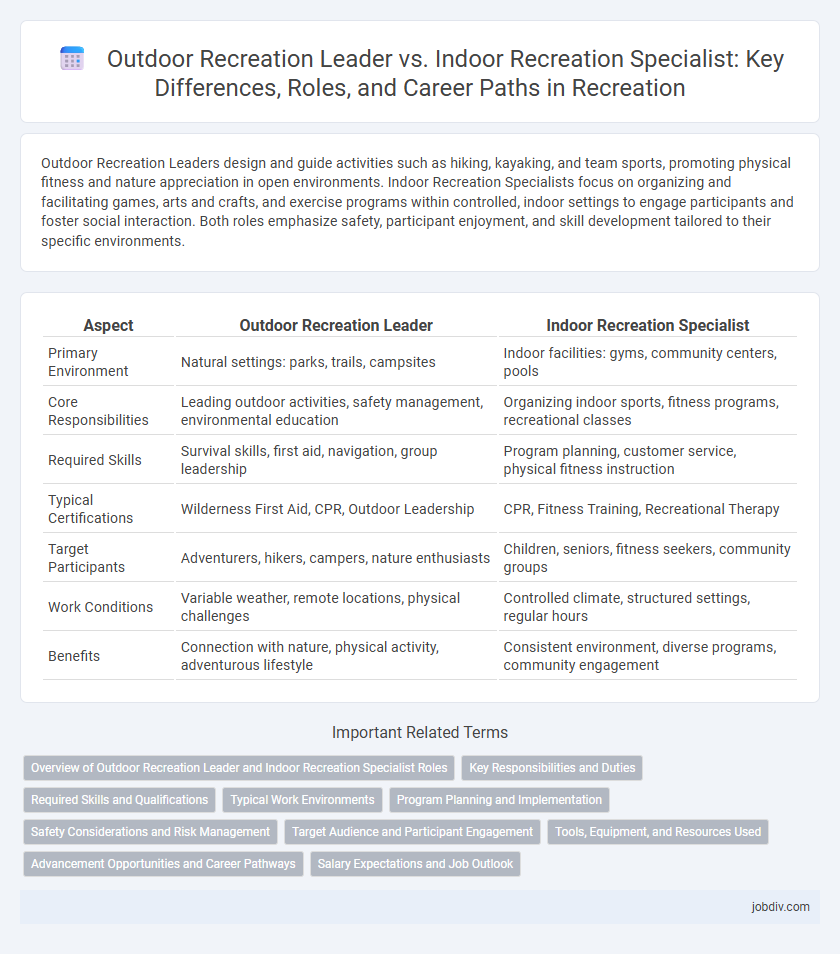Outdoor Recreation Leaders design and guide activities such as hiking, kayaking, and team sports, promoting physical fitness and nature appreciation in open environments. Indoor Recreation Specialists focus on organizing and facilitating games, arts and crafts, and exercise programs within controlled, indoor settings to engage participants and foster social interaction. Both roles emphasize safety, participant enjoyment, and skill development tailored to their specific environments.
Table of Comparison
| Aspect | Outdoor Recreation Leader | Indoor Recreation Specialist |
|---|---|---|
| Primary Environment | Natural settings: parks, trails, campsites | Indoor facilities: gyms, community centers, pools |
| Core Responsibilities | Leading outdoor activities, safety management, environmental education | Organizing indoor sports, fitness programs, recreational classes |
| Required Skills | Survival skills, first aid, navigation, group leadership | Program planning, customer service, physical fitness instruction |
| Typical Certifications | Wilderness First Aid, CPR, Outdoor Leadership | CPR, Fitness Training, Recreational Therapy |
| Target Participants | Adventurers, hikers, campers, nature enthusiasts | Children, seniors, fitness seekers, community groups |
| Work Conditions | Variable weather, remote locations, physical challenges | Controlled climate, structured settings, regular hours |
| Benefits | Connection with nature, physical activity, adventurous lifestyle | Consistent environment, diverse programs, community engagement |
Overview of Outdoor Recreation Leader and Indoor Recreation Specialist Roles
Outdoor Recreation Leaders design and facilitate activities such as hiking, kayaking, and camping, ensuring safety and engagement in natural settings, while managing group dynamics and environmental stewardship. Indoor Recreation Specialists plan and implement recreational programs within facilities like community centers, gyms, and recreation halls, focusing on fitness classes, games, and social events tailored to diverse populations. Both roles require strong leadership, program development skills, and a commitment to enhancing participant well-being through recreational activities.
Key Responsibilities and Duties
Outdoor Recreation Leaders design and facilitate activities such as hiking, camping, and adventure sports, ensuring safety protocols and environmental stewardship. Indoor Recreation Specialists manage facility-based programs like fitness classes, arts and crafts, and team sports, focusing on participant engagement and equipment maintenance. Both roles require strong leadership, risk management skills, and the ability to adapt programming to diverse participant needs.
Required Skills and Qualifications
Outdoor Recreation Leaders require strong physical fitness, wilderness survival skills, and expertise in navigation and first aid to effectively manage activities such as hiking, camping, and outdoor team sports. Indoor Recreation Specialists need skills in facility management, program planning, and interpersonal communication to coordinate activities like fitness classes, arts and crafts, and indoor sports. Both roles demand certification in safety protocols and the ability to engage diverse participant groups.
Typical Work Environments
Outdoor Recreation Leaders typically work in natural settings such as national parks, forests, and campgrounds where they organize activities like hiking, kayaking, and wildlife tours. Indoor Recreation Specialists operate in controlled environments including community centers, gyms, and recreation facilities, focusing on sports leagues, fitness classes, and social events. Both roles require adaptability to their respective environments to ensure participant safety and engagement.
Program Planning and Implementation
Outdoor Recreation Leaders excel in program planning by designing activities that leverage natural settings, emphasizing environmental engagement and physical challenge. Indoor Recreation Specialists focus on creating safe, accessible environments for diverse groups, implementing structured activities that promote social interaction and cognitive development. Both roles prioritize safety and participant satisfaction but differ in spatial context and activity types, influencing their approach to program logistics and resource management.
Safety Considerations and Risk Management
Outdoor Recreation Leaders prioritize safety through environmental hazard assessments, weather monitoring, and wilderness first aid training to manage risks associated with natural terrain and unpredictable conditions. Indoor Recreation Specialists focus on maintaining facility safety standards, emergency response protocols, and equipment inspections to minimize risks within controlled environments. Both roles implement tailored risk management strategies to ensure participant well-being but differ in their approach based on the recreational setting's inherent challenges.
Target Audience and Participant Engagement
Outdoor Recreation Leaders engage adventure enthusiasts and nature lovers by organizing activities like hiking, camping, and kayaking, fostering experiential learning and physical challenges in natural settings. Indoor Recreation Specialists target community members seeking structured, accessible programs such as fitness classes, arts and crafts, or sports leagues, enhancing social interaction and skill development in controlled environments. Both roles prioritize participant engagement through tailored programming that meets the specific interests and abilities of their audiences, maximizing enjoyment and inclusivity.
Tools, Equipment, and Resources Used
Outdoor Recreation Leaders utilize tools such as GPS devices, climbing gear, kayaks, and survival equipment to facilitate activities like hiking, rock climbing, and water sports. Indoor Recreation Specialists rely on video game consoles, fitness machines, craft supplies, and virtual reality systems to engage participants in structured, indoor recreational programs. Both roles require specialized resources tailored to their environments to ensure safety, enjoyment, and effective program delivery.
Advancement Opportunities and Career Pathways
Outdoor Recreation Leaders typically advance into roles such as park managers, wilderness program coordinators, or adventure tourism directors, leveraging field expertise and certifications in areas like wilderness first aid or environmental education. Indoor Recreation Specialists often pursue career growth in community center management, therapeutic recreation coordination, or fitness program directing, benefiting from certifications in CPR, adaptive recreation, or wellness coaching. Both career paths offer opportunities for specialization, leadership, and upward mobility within public, private, and nonprofit recreation organizations.
Salary Expectations and Job Outlook
Outdoor Recreation Leaders typically earn salaries ranging from $35,000 to $55,000 annually, with job growth projected at 5% due to increasing interest in nature-based activities. Indoor Recreation Specialists command salaries between $30,000 and $50,000, benefiting from steady demand in community centers and recreational facilities with a 4% growth outlook. Both roles require strong interpersonal skills, but outdoor positions often offer higher pay linked to seasonal and location factors, while indoor specialists enjoy more stable year-round employment.
Outdoor Recreation Leader vs Indoor Recreation Specialist Infographic

 jobdiv.com
jobdiv.com